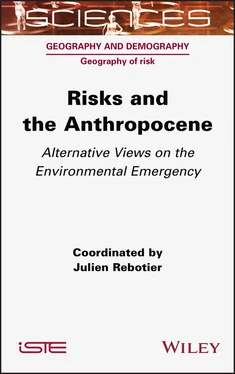Several lessons can be drawn from social sciences readings of the Anthropocene. These echo the persistent and structuring variety found in risk studies. Bringing together debates on the Anthropocene and reflections on risk allows us to confirm, complete and even deepen certain recurring obstacles and challenges in the understanding and management of disaster risks, as well as of the environmental question more broadly.
I.3. Risks and social sciences: well-identified obstacles and challenges that continue to be debated
I.3.1. The blind spot of development
Ben Wisner defines “disaster studies” as:
A broad interdisciplinary attempt to understand the causes and consequences of events that cause sufficient harm and loss that assistance is required from people and/or institutions unaffected, whatever size of the group and area affected. (Wisner 2019, p. 48)
This very open definition of a composite field leaves unresolved the questions that concern “the causes and effects of events that lead to damage”. Since the second half of the 20th century, a growing part of research has been devoted to the denaturalization of so-called natural hazards (O’Keefe et al. 1976). But the social processes put forward are based on different, sometimes antagonistic, visions of the social world and relationships with the environment. It is sometimes a question of being attentive to the behavior of individuals, sometimes to the response capacities of communities, sometimes to the effects of framing social structures, among many other approaches. Alongside this polyphony of social sciences around disaster risks, the understanding and treatment of hazards continue to be a major focus of attention, effort (and resources) of research and social demand:
Four decades of academic literature on disasters (e.g. Baird et al. 1975; Maskrey, 1989; Oliver-Smith, 1994), backed up by a profusion of practitioners’ reports from the field (e.g. Anderson and Woodrow 1989; Heijmans and Victoria 2001), have shown that disasters deeply reflect failed or skewed development. Considering vulnerability to natural hazards through the sole lens of potential damage created by rare and extreme natural phenomena is a remnant of a paradigm that has been completely up-ended. (Wisner et al. 2012, p. 11)
In a literature that purports to be intermediate between academia and action, despite an observation that is now half a century old, the challenge remains:
If disaster risk is an endogenous indicator of a flawed development model, then progress toward the policy goal of disaster risk reduction will depend on a transformation of that model. If the world is to survive beyond the middle of the 21st century... it will be necessary to make conclusive progress on the path that has been least followed under the Hyogo Framework for Action and to develop a new approach to disaster risk management. (GAR 2015, p. 39)
However, the GAR (Global Assessment Report on Disaster Risk Reduction) does not engage in the programmatic field. Yet the Sendai Framework for Action (2015–2030), which postdates the Hyogo Framework, does not meet the need to turn the correction of misguided development into the key driver of risk management either (Wisner 2016, p. 32). In theory, the relevance of social science input is no longer in dispute. In practice, misunderstandings and confusions persist about their place, scope and impact in research and management (Ribot 2019). This discrepancy should be seen in the light of the apparent contrast between the many efforts made to understand risks, on the one hand, and the observation of a simultaneous increase in damage, on the other hand (White et al. 2001).
I.3.2. Risks and the Anthropocene: updating or evacuating social science questions?
I.3.2.1. Old themes that are still relevant
Given both the importance of the Earth sciences in framing the Anthropocene and the discrete consequences of critical social science work in the field, one might ask whether the Anthropocene is advancing a meaningful research agenda on risk, or whether, on the contrary, it is helping to make certain social science productions incidental. The themes found around the Anthropocene are illustrated by these five examples:
– Knowledge: there is not a single piece of knowledge, but varying forms of knowledge, which may or may not be scientific, may not always be compatible and may sometimes be in competition to aid understanding of the “causes and consequences” of harmful events (Mercer 2012). The social sciences are equipped to decipher the meanings encapsulated in the different acceptations of the notions mobilized (Demeritt 2001; O’Brien et al. 2007; Hulme 2009; Bonneuil 2015). Knowledge never evolves alone, independently of the social world in which it is produced and conveyed.
– Technocracy and dogmatism: the decision founded in science remains a political arbitration. On the one hand, the practice of science and the legitimacy it enjoys – not to mention the heterogeneity of the scientific field – are a matter of social relations and therefore of politics (Bourdieu 1975). On the other hand, recourse to science to decide is always selective. It depends on the moment, on the context or on the underlying conceptualizations that presume a reading of the world. If they are not made explicit, they are ideology. Pretending to avoid arbitrations on the grounds that geology or atmospheric sciences would know neither morality nor subjectivity is an act of faith.
– Scientific polyphony: for risks as for the Anthropocene, the diversity of social science productions is considerable. This introduction has mentioned work on both risks and the Anthropocene. In both cases, there is no consensus on the analysis of the social dimensions of environmental issues, and there is a wide range between utilitarian reflections, in line with Earth science approaches, on the one hand, and the analysis of the environmental dimensions of the social, on the other hand. This diversity, characteristic of the epistemology of the social sciences (Passeron 1995), enriches interpretation but can feed confusion and so be detrimental to such environmental research.
– Interdisciplinarity and integration: it is now commonplace to denounce the fragmentation of research into silos, particularly in the case of subjects such as risk. We distinguish two forms of integration called for in response. One concerns the conditions of research; the other concerns the decompartmentalization of disciplines around the society–environment relationships that are the hallmark of geography and constitute one of its historical markers.
– The power of capture of one legitimate research sector over another is known (Castree et al. 2014). Some promote the broad field of “sustainability sciences” (Lorimer 2017) or embrace the unifying dynamics of “environmental sciences” with the Anthropocene (Brondizio et al. 2016). Others denounce it, see the opportunity to think differently (Palsson et al. 2013) and resist falling into line with a poorly controlled framing of research. In particular, the debate stumbles over modeling or indicators, in fact over reluctance to put an irreducibly diverse social world into functional equivalence (numerical or not) (Wisner 2016). Extracting the figure from its context also cuts the data from its meaning (Rebotier et al. 2019) and contributes to dehistoricizing the analysis (Moore 2003).
– Historically, risk studies have endorsed the separation between nature and culture (between hazard and vulnerability). This is particularly visible in the use of conceptual models that struggle to articulate physical processes and social mechanisms in a complex and explicit way (Pigeon and Rebotier 2016; García Acosta and Musset 2018). The Anthropocene moment may offer an opportunity to think about the post-great divide between nature and culture. But integrated ways of considering the reciprocal and non-deterministic relationships between societies and environments were already among the founding debates of geography at the turn of the 19th and 20th centuries (Berdoulay 2008). The trajectory of the notion of adaptation is an illustration of this (Rebotier 2020), and calls for more integrated research on the environment, at least in Francophone geography, and predates the Anthropocene moment (Mathieu and Jollivet 1989).
Читать дальше












